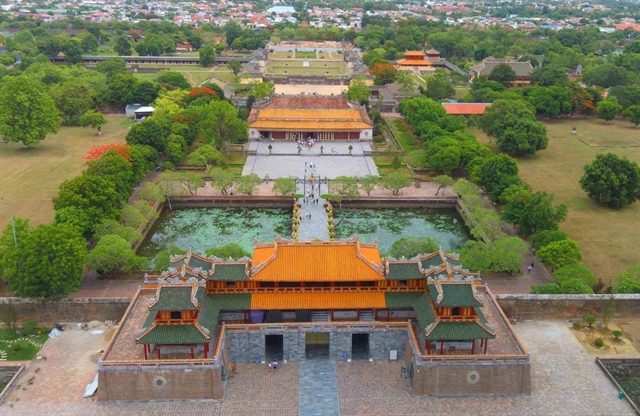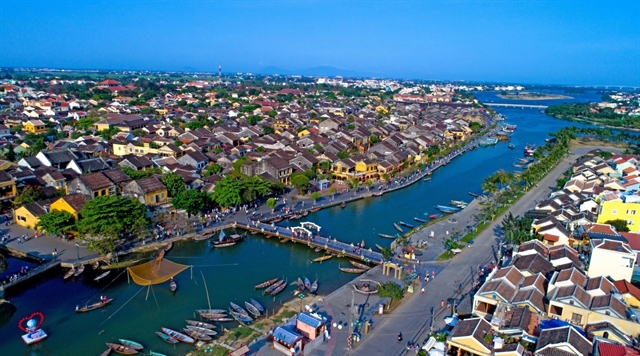 Life & Style
Life & Style


|
| Huế Citadel is part of the Complex of Huế Monuments which has been recognised by UNESCO as a World Cultural Heritage. — VNA/VNS Photo |
HÀ NỘI — Central Việt Nam is a land steeped in history and culture, home to three UNESCO-recognised world cultural heritage sites: the Complex of Huế Monuments, Hội An Ancient Town, and Mỹ Sơn Sanctuary. Once forgotten and left in ruins, these treasures have been beautifully restored and now shine as symbols of Việt Nam's cultural renaissance.
The journey of heritage revival
The Complex of Huế Monuments (in Huế City), Hội An Ancient Town, and Mỹ Sơn Sanctuary (in Đà Nẵng City) were inscribed on the UNESCO World Cultural Heritage List in 1993 and 1999. Since then, they have experienced a remarkable transformation, regaining their splendour and significance on the global stage.
The Complex of Huế Monuments was Việt Nam's first UNESCO-listed world cultural heritage site, recognised in December 1993. Over nearly four centuries (1558–1945), Huế served successively as the capital of the nine Nguyễn Lords in the South, the imperial seat of the Tây Sơn Dynasty, and the national capital under the 13 Nguyễn emperors.
The mention of Huế evokes images of grand citadels, golden palaces, solemn temples, tranquil pagodas, and poetic landscapes shaped by both nature and history.
Despite the passage of time, the former imperial capital continues to preserve its tangible and intangible heritage, reflecting the wisdom and soul of the Vietnamese people.
Constructed between the late fourth and 13th centuries under King Bhadravarman 1, Mỹ Sơn Sanctuary was dedicated to the Hindu god Shiva and became the most important religious and cultural centre of the ancient Champa Kingdom. The sanctuary, featuring an extensive complex of Hindu temples, was recognised as a world cultural heritage site by UNESCO in December 1999.
The temples of Mỹ Sơn exemplify the Champa religious architecture. Built primarily of brick using sophisticated techniques, they feature intricate carvings, decorative stone pillars, and sandstone sculptures depicting Hindu deities and legends.
Despite centuries of change, Mỹ Sơn retains its cultural and artistic value, with an architectural complex of Chăm temples that remain unique in Southeast Asia.
Located by the Cửa Đại estuary, Hội An Ancient Town flourished from the 16th century as one of the region’s busiest trading ports. Merchants from China, Japan, the Netherlands, India, and Spain once gathered here, giving rise to a distinctive fusion of Eastern and Western influences in the town’s architecture and culture. Earning the UNESCO recognition in December 1999, Hội An has since been the focus of extensive conservation efforts.
Hội An is home to 27 national-level relics, 49 provincial-level sites, and over 1,330 other protected monuments. Within the ancient quarter alone, there are 1,130 heritage sites, including nine of national and eight of provincial significance.
The revival and international acclaim of Huế, Hội An, and Mỹ Sơn are closely linked to the contributions by Polish architect Kazimierz Kwiatkowski (1944–1997), commonly known as Kazik. Arriving in Việt Nam in the early 1980s under a cooperation programme between the two Governments, Kazik helped restore the Chăm towers in Mỹ Sơn. Recognising the global significance of Huế and Hội An, he tirelessly advocated their preservation and promoted their values to the world.
Between 1997 and 2022, Mỹ Sơn’s restoration made great strides through partnerships with Italy and India, focusing on the restoration of tower groups G, H, K, and A. India is currently assisting with the rehabilitation of groups E and F, carried out between 2025 and 2030.

|
| The Mỹ Sơn Sanctuary in Đà Nẵng City was recognised as a world heritage site in 1999. — VNA/VNS Photo |
Heritage on the path to sustainable development
Decades after their UNESCO recognition, the cultural jewels of central Việt Nam – Huế, Hội An, and Mỹ Sơn – have been revitalised through strong state investment and international collaboration. Today, they continue to move forward on a path of sustainable development.
In response to the global trend of digital transformation in tourism, the three world heritage sites have embraced technology by introducing e-ticketing systems and digitalising artefacts and monuments. These innovations aim to not only popularise their images but also provide essential tools for conservation and restoration.
The Mỹ Sơn World Cultural Heritage Management Board has accelerated digitalisation to build a smart tourism ecosystem. The website myson360.vn offers visitors 3D and 360-degree perspectives of the temples, while Mỹ Sơn Metaverse/VR 360 integrates a virtual tour guide for immersive exploration.
Recognising the importance of digital preservation, the Huế Monuments Conservation Centre has collaborated with technology firms to 3D-digitise about 11,000 artefacts. The virtual exhibition space museehue.vn allows visitors to explore and learn more about Huế’s historical relics online.
Experts note that heritage digitalisation is essential for scientifically documenting and managing restoration work across different historical periods.
In Hội An, digital transformation has also expanded into tourism management, environmental monitoring, traffic system, and initiatives to improve residents’ quality of life.
Local authorities continue to mobilise community participation and social resources to safeguard and enhance the heritage values of these cultural landmarks.
Heritage as a gateway to the world

|
| A corner of Hội An Ancient Town from above. — Photo baoquangnam.vn |
With their exceptional universal values, the Complex of Huế Monuments, Mỹ Sơn Sanctuary, and Hội An Ancient Town serve as gateways introducing Việt Nam's traditional culture to the world, and as vital “gold mines” for the central region’s tourism industry.
Thousands of visitors flock to these sites daily, drawn by the harmonious blend of tangible and intangible heritage, where traditional culture meets modern innovation.
In Huế, the re-enactment of royal rituals as stage performances has emerged as a distinctive tourism product, vividly recreating imperial culture and historical narratives for visitors.
German visitor David Raum expressed his enthusiasm after witnessing the Changing of the Guard ceremony at Ngọ Môn (Noon Gate): “Such programmes are fascinating and emotional, allowing visitors to step back in time and truly connect with the site’s history.”
The Huế Festival has become a hallmark cultural and tourism brand. Through regular and creative editions, the festival reinforces Huế’s position as Việt Nam's national and international “Festival City”, showcasing the splendour of its heritage.
In Hội An, well-known events such as the Full Moon Night, Lantern Festival, and Hội An – Japan Cultural Exchange Festival, alongside the daily life of residents and traditional craft villages, continue to attract millions of visitors. The town expects to welcome around five million tourists in 2025.
World cultural heritage sites remain among the most sought-after destinations for travellers seeking authentic cultural and historical experiences.
Huế and Đà Nẵng are two of Việt Nam's leading tourism hubs, where heritage tourism plays a central role in driving the sustainable development of the “smokeless industry”.
With today’s convenient transport connections, visitors can easily travel between the three world heritage sites. In recent years, these destinations have recorded a rising visitor number and growing tourism revenue.
The enduring appeal of the Complex of Huế Monuments, Hội An Ancient Town, and Mỹ Sơn Sanctuary demonstrates that when cultural heritage is cherished and creatively promoted, it becomes a valuable and lasting resource for sustainable tourism, contributing to Việt Nam global image and sharing the nation’s cultural essence with the world. — VNA/VNS




